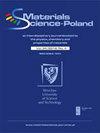Influence of mechanical activation on the behavior of green high-strength mortar including ceramic waste
IF 1.3
4区 材料科学
Q4 MATERIALS SCIENCE, MULTIDISCIPLINARY
引用次数: 0
Abstract
Solid waste management is a significant environmental issue for countries because of the need for huge landfills. The ceramic tile waste powder (CWP) is one of the wastes. Conversely, cement production, the main ingredient in concrete, emits large quantities of greenhouse gases, a significant environmental concern. Therefore, substituting some of the cement in concrete with CWP is an issue that deserves investigation to reduce the environmental impact of both materials. Accordingly, this study aims to investigate the influence of the grinding time and proportion of CWP as a substitute for cement on the properties of high-strength mortar (HSM). Three grinding times (10, 15, and 20 minutes) and three replacement percentages (10%, 20%, and 30% by weight) for CWP were adopted for each time. Ten mixtures (including the reference mixture) were executed. The fresh (flow rate), mechanical (compressive strength) durability (ultrasonic pulse velocity, dynamic elastic modulus, water absorption, density, percentage of voids and electrical resistivity) and microstructural properties were examined. The life cycle assessment (LCA) was also addressed. The results showed that the mechanical activation had a pronounced effect on the durability properties (especially water absorption and percentage of voids) more than on the compressive strength. Generally, a sustainable HSM (with more than 70 MPa of compressive strength) can be produced in which 30% of the cement was replaced with CWP with almost comparable performance to the CWP-free mortar. Furthermore, LCA results showed that mortars containing 30% CWP ground for 15 mins (GT15CWP30) had the lowest GWP per MPa.机械活化对含陶瓷废料的绿色高强度砂浆行为的影响
固体废物管理是各国面临的一个重大环境问题,因为需要大量的垃圾填埋场。瓷砖废粉(CWP)就是废物之一。相反,作为混凝土主要成分的水泥在生产过程中会排放大量温室气体,这是一个重大的环境问题。因此,用 CWP 替代混凝土中的部分水泥,以减少这两种材料对环境的影响,是一个值得研究的问题。因此,本研究旨在探讨水泥替代品 CWP 的研磨时间和比例对高强度砂浆(HSM)性能的影响。研究采用了三种研磨时间(10 分钟、15 分钟和 20 分钟)和三种 CWP 替代比例(按重量计分别为 10%、20% 和 30%)。执行了 10 种混合物(包括参考混合物)。对新鲜度(流动速率)、机械性能(抗压强度)、耐久性(超声波脉冲速度、动态弹性模量、吸水率、密度、空隙百分比和电阻率)和微观结构特性进行了检测。此外,还进行了生命周期评估(LCA)。结果表明,机械活化对耐久性能(尤其是吸水率和空隙率)的影响明显大于对抗压强度的影响。一般来说,用 CWP 替代 30% 的水泥可以生产出可持续的 HSM(抗压强度超过 70 兆帕),其性能几乎与不含 CWP 的砂浆相当。此外,生命周期评估结果表明,含 30% CWP 并研磨 15 分钟的灰泥(GT15CWP30)每兆帕的全球升温潜能值最低。
本文章由计算机程序翻译,如有差异,请以英文原文为准。
求助全文
约1分钟内获得全文
求助全文
来源期刊

Materials Science-Poland
MATERIALS SCIENCE, MULTIDISCIPLINARY-
自引率
18.20%
发文量
18
期刊介绍:
Material Sciences-Poland is an interdisciplinary journal devoted to experimental research into results on the relationships between structure, processing, properties, technology, and uses of materials. Original research articles and review can be only submitted.
 求助内容:
求助内容: 应助结果提醒方式:
应助结果提醒方式:


